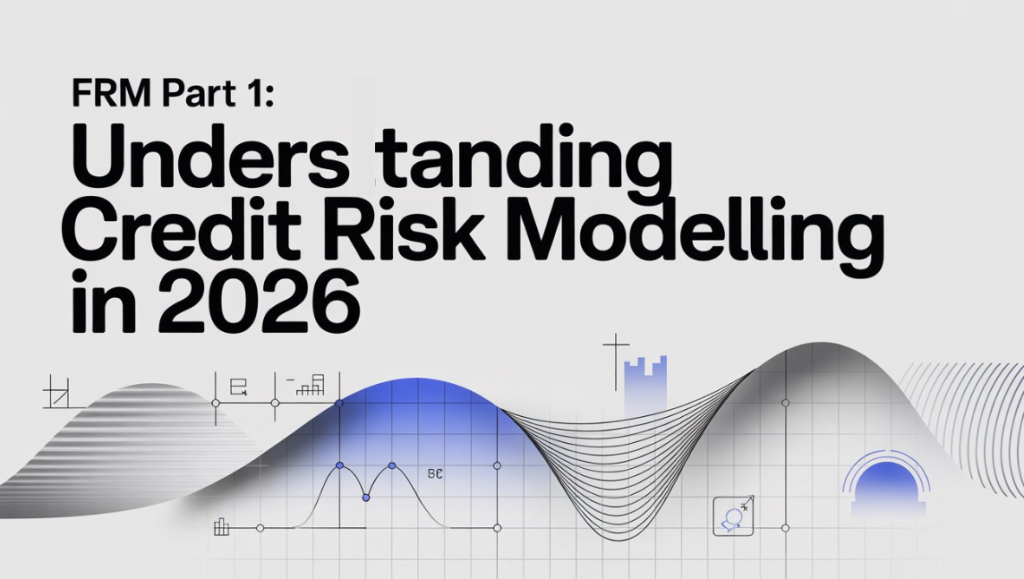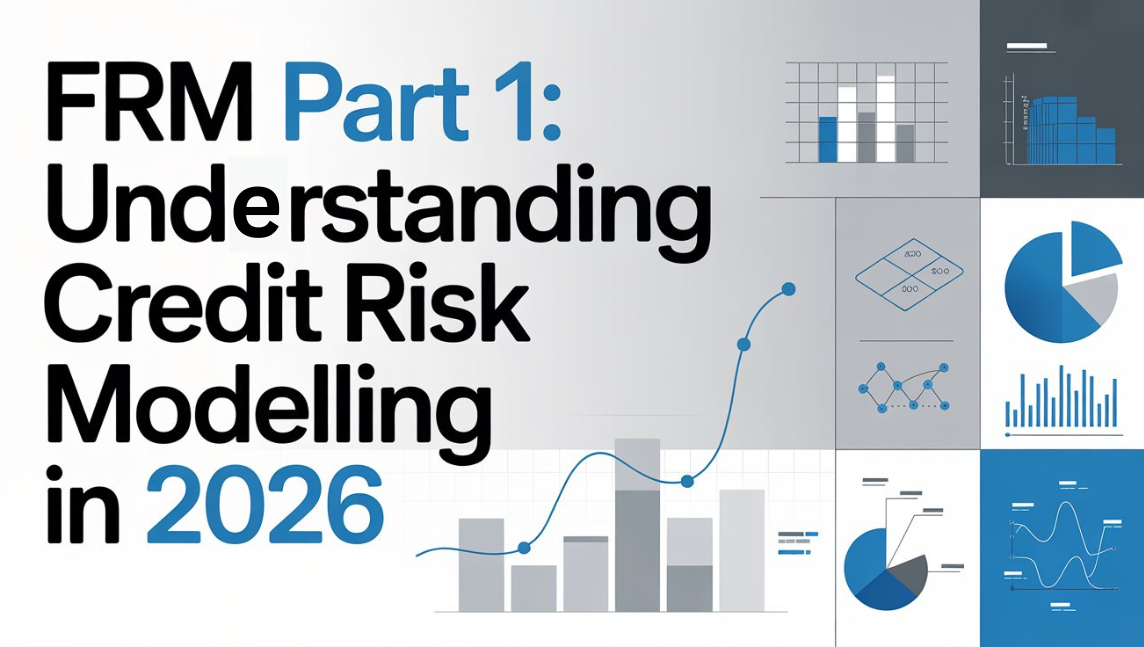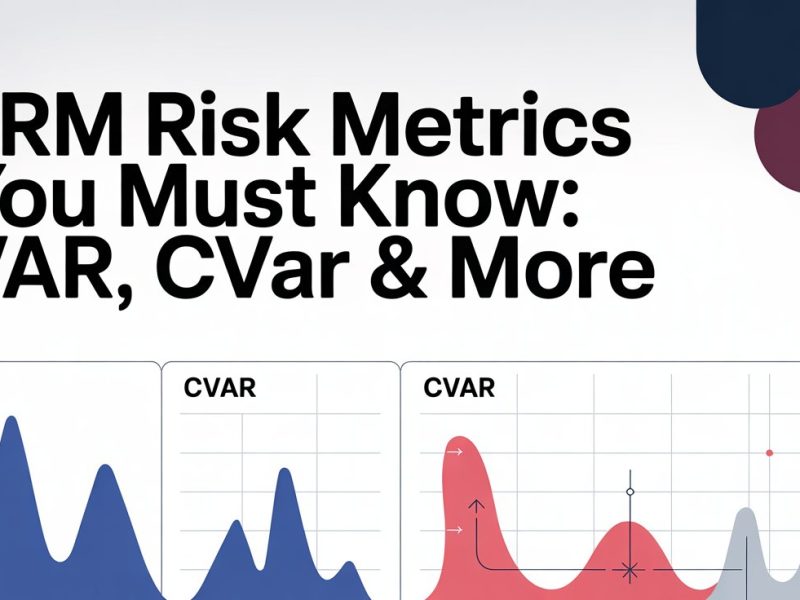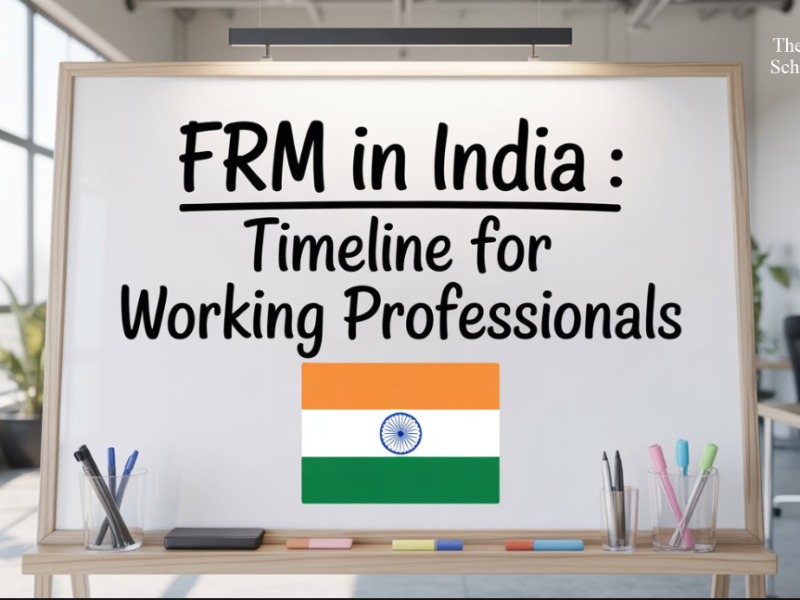If you’re preparing for the FRM Part 1 exam or building your chops in financial risk analysis, one topic you cannot ignore is credit risk modelling FRM.
This is not just another boring formula chapter – it’s the heartbeat of how banks, NBFCs, and fintechs measure and manage the risk of someone not paying back what they owe. And trust this, in 2026, it’s not just about crunching probabilities – it’s about understanding AI, real-time data, and how credit risk ties into global finance.
So let’s break it all down from core theory to risk models 2026.
Why Credit Risk Modelling Matters So Much in FRM Part 1
Credit risk isn’t just about “someone defaulting on a loan.”
It’s about understanding how likely that default is, how bad the loss could be, and how to prepare for it financially.
In the FRM syllabus, this comes under the “Valuation & Risk Models” section. It’s a heavy hitter in the exam, and honestly, it’s also one of the most practical things you’ll learn.
Why? Because everything in modern finance, from digital lending to corporate bonds to credit cards, runs on managing default risk smartly and most of these decisions rely on strong credit risk modelling FRM foundations.
And in 2026, credit risk modelling is not just about plugging formulas anymore. It’s about AI-powered models, real-time data, and a stronger connection to financial innovation like credit default swaps (CDS).
So if you’re aiming to future-proof your career, this is the topic to master.
Core Building Blocks: The Basics You Need to Nail
Before diving into AI and fancy analytics, you’ve got to understand the ABCs – PD, LGD, and EAD. These three are like the holy trinity of credit risk modelling FRM, and they’re heavily tested during FRM part 1 preparation.
1. Probability of Default (PD)
This is basically the chance that a borrower will fail to pay back. If a company has a PD of 2%, that means out of 100 similar companies, around 2 might default within a given period.
2. Loss Given Default (LGD)
Let’s say a company defaults. How much will the lender actually lose after recovery? That’s LGD, usually expressed as a percentage of exposure.
3. Exposure at Default (EAD)
That’s the total amount at risk when the default happens. Think of it as “the total money on the table.”
Put them together and you get the most famous formula in the FRM world:
Expected Loss (EL) = PD × LGD × EAD
This formula sits at the core of credit risk modelling FRM. It’s a simple but don’t just memorise it – understand it. FRM examiners love testing your intuition, not just your memory.
Expected Loss (EL) vs. Unexpected Loss (UL)
Here’s where students often get tripped up.
- Expected Loss (EL) is like the average loss you know is coming – common across financial risk analysis.
- Unexpected Loss (UL) is the shock loss. The kind that hits when the economy tanks or a big borrower defaults unexpectedly. Understanding UL is critical for both credit risk modelling FRM and strong FRM part 1 preparation.
Banks hold capital mainly for UL because that’s what really threatens their survival.
So when you’re doing your FRM part 1 preparation, make sure you understand why UL matters – it’s not just another formula to memorise, it’s about resilience.
Portfolio Credit Risk, Correlation, and Models
One borrower defaulting is bad.
But multiple borrowers defaulting together? That’s a nightmare and that’s what correlation modelling is a huge part of credit risk modelling FRM.
In credit portfolios, defaults can be interconnected (for example, during an economic downturn).
This is where models like the Gaussian Copula and Vasicek model come in. They help estimate how correlated defaults can blow up total portfolio losses.
Also, know about structural models like the Merton model, which uses a company’s asset value to estimate default risk.
Pro Tip: You don’t have to dive deep into derivations for FRM Part 1, but knowing how these models differ conceptually is a huge plus.
Credit Default Swaps (CDS): The Insurance Against Credit Risk
A CDS is like an insurance policy against default. One party pays regular fees (the protection buyer), and if the borrower defaults, the other party (the seller) pays up.
In credit risk modelling, CDS data helps price and transfer credit risk across financial institutions. CDS insights also strengthen your credit risk modelling FRM understanding.
Even though FRM Part 1 doesn’t test credit default swaps heavily, understanding the logic gives you a serious edge – especially when you move to FRM Part 2 or work in risk analysis.
Risk Models 2026: What’s Changing
The financial world is evolving, and so is the way we model credit risk. Let’s talk about what’s new and why you should care.
1. AI, Machine Learning, and Big Data
Forget old-school regression models – we’re now in the era of AI and ML-driven credit scoring. These techniques now influence credit risk modelling FRM and the future of financial risk analysis.
Banks and fintechs are using machine learning to detect default patterns that traditional models miss. They’re even pulling data from new sources like:
- Payment app histories
- Utility bill payments
- Social media signals
- Real-time transaction data
The result? More accurate and dynamic risk predictions.
If you’re prepping for FRM Part 1, you don’t need to know algorithms like Random Forest or XGBoost – just understand why these are used: they capture complex, non-linear relationships better than old-school equations.
2. Explainable AI and Model Governance
Here’s the catch with AI – it can be a black box.
If regulators or management can’t understand why the model flagged someone as risky, that’s a problem.
That’s where Explainable AI (XAI) comes in. It’s about making ML models transparent and fair.
Add to that data drift – when your model performance changes over time because the world changes, and you’ve got a whole new category of “model risk.”
Model governance is now a bigger focus in the industry and is appearing more often in exams. Candidates should understand its main concepts.
3. Real-Time Credit Scoring and Fintech Disruption
Old credit risk models used to work with static data quarterly or annual updates.
Now? Fintechs want real-time scoring based on live data streams.
Imagine your credit risk score updating instantly when you miss a UPI payment – that’s the world we’re heading toward.
This is what defines risk models 2026: agile, adaptive, and constantly learning.
4. ESG and Green Lending
Here’s another 2026 trend you can’t ignore.
Banks are under pressure to model credit risk for green and ESG-linked loans differently.
Why? Because these loans have unique risk characteristics – they may depend on climate outcomes, sustainability metrics, or policy incentives.
If you’re eyeing a career in financial risk analysis, knowing ESG risk factors can make you way more valuable in the job market.

Practical Credit Risk Modelling FRM Workflow
Here’s how everything connects in real life (and how examiners expect you to think):
- Define exposures – What’s your credit universe?
- Choose your model – Structural, reduced-form, or hybrid ML.
- Calibrate PD, LGD, and EAD – Use data or estimates.
- Simulate portfolio loss distribution – check diversification and tail risk.
- Compute EL and UL – Quantify expected and unexpected loss.
- Stress test – What happens under crisis scenarios?
- Validate and monitor – Make sure your model stays accurate over time.
Include credit default swaps exposure if your portfolio involves derivatives or credit-linked products. A Concept often explored in Credit Risk Modelling FRM case studies and practical examples.
| Feature | Classical (FRM Staple) | Next-Gen (2026) |
| Data | Historical defaults, credit ratings | Real-time, alternative, unstructured data |
| Method | Regression, Copula, Vasicek | Machine Learning, Hybrid Models |
| Output | PD/LGD/EAD, EL/UL | Predictive scores, exposure trends, model drift alerts |
| Governance | Static validation | Continuous monitoring, Explainable AI, fairness checks |
This table alone can win you bonus marks in an FRM answer – it shows you understand evolution, not just equations.
Common Mistakes Students Make
Honestly, it’s not the math that trips people up. It’s trying to memorise every formula without getting what’s actually happening behind the numbers.
Here’s what to avoid:
- Memorising formulas without understanding what they mean.
- Ignoring Unexpected Loss – the most important driver of capital.
- Forgetting the link between credit risk, market risk, and derivatives.
- Skipping model governance – super relevant for 2026 and beyond.
- Assuming the syllabus doesn’t change – it evolves, especially with fintech and real-time models coming in.
If you truly want to ace FRM Part 1 preparation, approach credit risk modelling like a living, breathing subject – not a static chapter.
Final Thoughts
Credit Risk Modelling in FRM isn’t just another exam topic – it’s the heartbeat of modern risk management. From understanding defaults to predicting them with AI, this is where theory meets real impact.
So don’t just study to pass. Study to think like a risk modeller. Because when markets shift and they always do – it’s the thinkers, not the memorisers, who lead.
Ready to train that mindset? The WallStreet School’s FRM Program helps you master concepts, not cram them – so you can think critically, analyse risk like a pro, and stay ahead FRM part 1 preparation where it truly counts.
People Also Asked:-
1. Is credit risk modelling a good career?
Ans. Yes, it’s a great career with strong demand, high salaries, and global opportunities in finance and banking.
2. What are the 7 C’s of credit analysis?
Ans. Character, Capacity, Capital, Collateral, Conditions, Control, and Common sense guide lenders in evaluating borrowers’ creditworthiness.
3. What are the 7 P’s of credit?
Ans. Personality, Purpose, Payment, Protection, Policy, Pricing, and Profitability define the 7 P’s of sound credit management.



